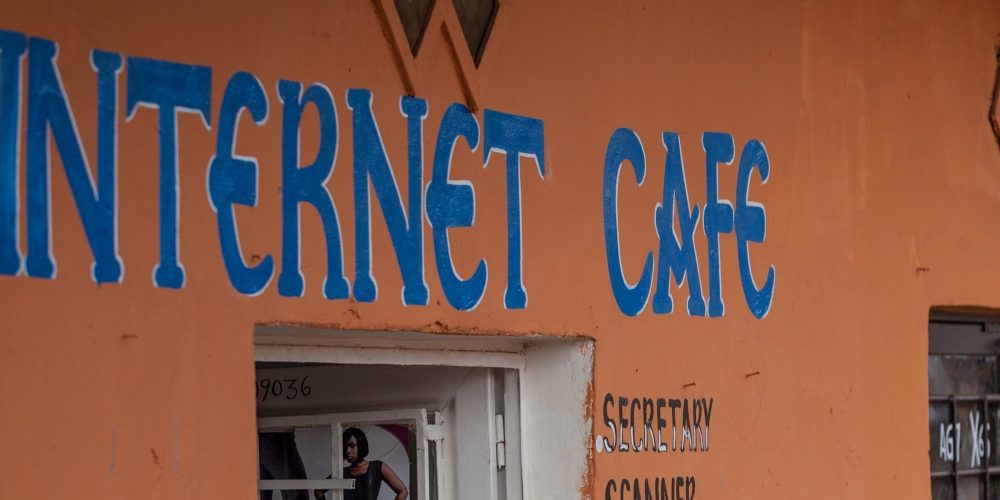Internet cafe in the neighborhood of Nyamirambo in Kigali, Rwanda. (Sarah Farhat/ World Bank)
By Aparna Krishnamurthy, Namita Datta, Georges V. Houngbonon, Todd Cotts
Broadband (or high-speed) internet access plays a major role in economic growth and job creation. COVID-19 has accelerated the transition to home-based work, reinforcing the need for broadband connectivity. A recent World Bank study finds that the potential for home-based work is strongly linked to internet penetration.
Broadband access can stimulate youth employment opportunities in rural communities. In addition to creating direct jobs in the construction, installation, and maintenance of network equipment, the “indirect” and “induced” jobs that come from the ability to use the internet are significant. Previous research indicated that an investment in a broadband stimulus package in the US was estimated to create 64,000 direct jobs in the telecommunications and electronic manufacturing sectors as well as an additional 166,000 indirect and induced jobs across various industries. In Malaysia, it is estimated that a broadband penetration rate of 50 percent could create 329,000 jobs by 2022. Rural communities can take on a significant portion of those new jobs.
Given that the pandemic has accelerated consumption of digitally enabled goods and services as well as the reorganization of production to home-based work, these numbers are likely to be an under-estimation.
In Solutions for Youth Employment (S4YE)’s “Insights from the Private Sector” webinar series, IFC and satellite telecoms company Intelsat discussed the benefits of bringing broadband to rural areas.
The discussion helped identify three ways in which broadband is enabling youth employment opportunities in rural communities around the world.
1. Boosting employment across industries: A World Bank study estimates that each broadband-enabled job creates between 2.5 and 4.0 additional jobs across industries.
For example, in rural areas a significant barrier to broadband access is the lack of electricity. In response to this challenge, telecom companies are partnering with energy services companies to offer pay-to-own solar home systems bundled with mobile connectivity and public Wi-Fi access points. This business model has stimulated job opportunities in the energy sector, particularly in the installation, distribution, sales, and maintenance of renewable energy solutions.
2. Spurring entrepreneurship and self-employment in rural communities: Over two-thirds of the world’s unconnected communities live in rural areas, where prohibitive costs, low return on investment, and challenging geographical terrains often present barriers to connectivity. For example, Intelsat connects remote communities in Africa through satellite-enabled Wi-Fi services. In 2017, Intelsat and Coca-Cola partnered to provide Wi-Fi powered retail kiosks across Kenya, Rwanda, and Tanzania. Typically run by local women entrepreneurs, these kiosks provide utilities including safe drinking water, solar lamps, and internet to the community. These kiosks have become a hub of commercial activities, stimulating entrepreneurship and self-employment.
Telecom companies can also support the emergence of informal retail and distribution networks. Mobile airtime distribution in many countries takes place through informal retailers via kiosks and open-air markets. Safaricom, a Kenyan mobile network operator, distributes its airtime credit cards through hawkers. Over 80,000 micro-retailers work as agents for their M-Pesa mobile money system.
3. Creating new job opportunities through e-commerce and digital platforms: Digital platforms match buyers and sellers in a virtual marketplace, offering scale at essentially zero marginal costs, which creates new business models, lowers the cost of entry for small and medium enterprises, and creates jobs.
This rise in e-commerce has also spawned several e-logistics companies that have opened up opportunities for low-income drivers. For example, Shadowfax, an Indian company supported by IFC, hires motorbike drivers to deliver packages. These motorbike riders are typically single-owned businesses. Over 25,000 active drivers are registered on the Shadowfax platform.
Broadband connectivity empowers communities, spurs innovation, and increases productivity. However, simply enabling access to broadband may not be enough. Access must be supplemented with affordable technology, the knowledge and skills to use the technology meaningfully, and creation of more relevant and contextual technology solutions. COVID-19 has reminded us that the benefits and opportunities of technology are not equitably distributed, particularly in rural and poor communities.
There is a tremendous opportunity for rural broadband expansion projects (financed by multilaterals or the private sector or governments themselves) to be accompanied with targeted interventions on job creation. An example of such a project is the World Bank’s Digital Economy Project for Kosovo, an infrastructure broadband expansion project that has a built-in component on digital jobs.
Key stakeholder partnerships between governments, academics, private sector, and multilateral organizations will be critical in advancing this effort.
This blog is part of the ‘S4YE – Insights from the Private Sector’ webinar series, an ongoing web series that facilitates dialogue between youth employment practitioners and private sector companies around the world. The webinar series especially highlights lessons from youth-focused initiatives that are being led by the private sector. This is an opportunity for the community to connect, learn from each other, and share experiences.




